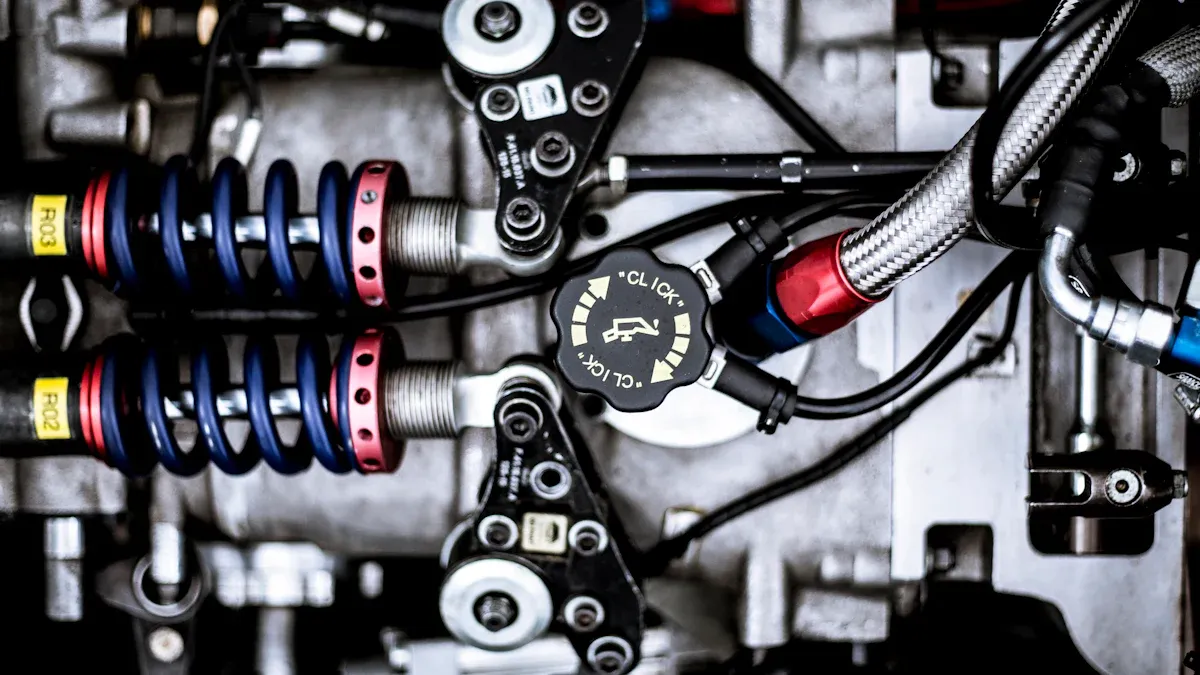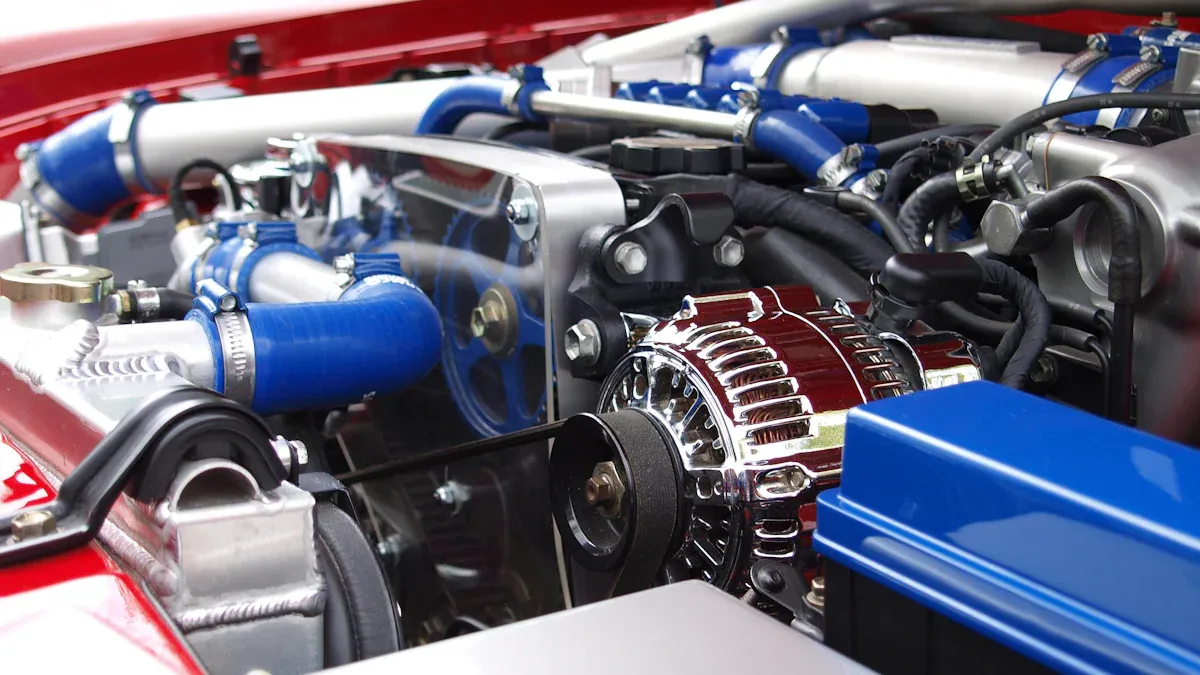
You want your vehicle to last longer and perform better. TAC coating offers a proven way to boost the durability of automotive components. Its advanced properties, like wear resistance, make it stand out. Unlike traditional SiC coating or CVD coating, TAC coating provides superior protection against corrosion. This innovation ensures your car’s parts stay reliable for years.
Key Takeaways
- TAC Coating makes car parts stronger by stopping wear and rust.
- It lowers repair costs and helps cars run better by reducing friction.
- To use TAC Coating, check parts, work with good suppliers, and add it to production.
What is TAC Coating?
Definition and Composition
TAC Coating, short for Tetrahedral Amorphous Carbon Coating, is a thin protective layer applied to automotive components. It consists of carbon atoms arranged in a unique structure that combines the hardness of diamond with the smoothness of graphite. This advanced composition gives it exceptional durability and versatility. Manufacturers use specialized techniques to apply TAC Coating, ensuring a uniform layer that adheres tightly to the surface of the component.
You’ll find that TAC Coating is not just a single material but a blend of properties designed to meet the demands of modern automotive engineering. Its composition allows it to resist wear, reduce friction, and protect against environmental damage. These qualities make it a game-changer for enhancing the performance of critical automotive parts.
Unique Properties and Advantages
TAC Coating offers several unique properties that set it apart. Its wear resistance ensures that components last longer, even under constant use. The coating also provides excellent corrosion protection, shielding parts from moisture, chemicals, and other harmful elements. This makes it ideal for vehicles operating in harsh environments.
Another advantage is its ability to reduce friction. By minimizing surface contact between moving parts, TAC Coating improves efficiency and reduces energy loss. This not only enhances performance but also lowers maintenance costs over time. Additionally, the coating performs well under extreme temperatures and pressures, making it suitable for high-stress applications like engines and transmissions.
When you choose TAC Coating, you invest in a solution that combines durability, efficiency, and reliability. Its unique properties make it an essential tool for modern automotive manufacturing.
How TAC Coating Enhances Durability

Mechanisms of Wear Resistance
TAC Coating strengthens automotive components by reducing wear caused by friction. When parts rub against each other, they gradually lose material, which weakens their structure. TAC Coating creates a hard, protective layer that minimizes this material loss. Its diamond-like hardness ensures that moving parts, such as gears and pistons, stay intact even after prolonged use.
You’ll notice smoother operation in components treated with TAC Coating. This is because the coating reduces surface roughness, allowing parts to glide effortlessly. As a result, your vehicle experiences less mechanical stress, which extends the lifespan of critical components.
Corrosion Protection and Longevity
Corrosion can severely damage automotive parts, especially in environments with high humidity or exposure to road salts. TAC Coating acts as a shield, preventing moisture and chemicals from reaching the metal surface. This barrier keeps rust and other forms of corrosion at bay.
By protecting against corrosion, TAC Coating ensures that your vehicle’s parts remain reliable for years. You won’t have to worry about frequent replacements or repairs, saving both time and money. This durability makes it an excellent choice for vehicles operating in challenging conditions.
Performance Under Stressful Conditions
Automotive components often face extreme temperatures, high pressures, and constant vibrations. TAC Coating excels in these demanding environments. Its unique structure resists cracking and deformation, even under intense stress.
For example, engine parts coated with TAC Coating maintain their integrity during rapid temperature changes. This reliability ensures consistent performance, whether you’re driving in freezing winters or scorching summers. With TAC Coating, your vehicle stays dependable, no matter the conditions.
Real-World Applications of TAC Coating

Engine Components
You rely on your engine to deliver consistent performance, and TAC Coating plays a vital role in making that happen. Engine parts like pistons, camshafts, and valves face constant friction and high temperatures. Without proper protection, these components wear out quickly. TAC Coating creates a hard, smooth surface that reduces friction and prevents material loss. This ensures your engine runs efficiently and lasts longer.
The coating also protects against heat damage. It maintains its integrity even under extreme temperatures, which is crucial for parts exposed to combustion. By using TAC Coating, you can reduce the risk of engine failure and improve overall reliability.
Transmissions and Drivetrains
Your vehicle’s transmission and drivetrain are essential for transferring power to the wheels. These systems involve multiple moving parts, such as gears and shafts, that experience significant stress. TAC Coating minimizes wear and tear by reducing friction between these components. This leads to smoother gear shifts and improved power delivery.
The coating also enhances durability by protecting parts from corrosion. This is especially important for vehicles operating in wet or salty environments. With TAC Coating, your transmission and drivetrain remain dependable, even under challenging conditions.
Suspension and Chassis Systems
Suspension and chassis systems ensure a comfortable and stable ride. However, they often face harsh conditions, including road debris, moisture, and vibrations. TAC Coating provides a protective layer that shields these components from damage. It prevents rust and reduces the impact of wear, extending the lifespan of critical parts like control arms and shock absorbers.
By using TAC Coating, you can maintain the structural integrity of your vehicle’s suspension and chassis. This not only improves safety but also reduces maintenance costs over time.
Benefits of TAC Coating Over Alternatives
Comparison with Traditional Coatings
When you compare TAC Coating to traditional coatings like chrome or nickel plating, the differences become clear. Traditional coatings often struggle with wear and corrosion over time. They may crack or peel under stress, leaving components vulnerable. TAC Coating, on the other hand, offers superior durability. Its diamond-like hardness resists wear, while its smooth surface reduces friction. This combination ensures that parts last longer and perform better.
Traditional coatings also lack the versatility of TAC Coating. They may work well in specific conditions but fail in extreme environments. TAC Coating adapts to a wide range of applications, making it a more reliable choice for modern vehicles.
Cost-Effectiveness and Efficiency
You might think advanced coatings like TAC Coating are expensive, but they save money in the long run. By reducing wear and corrosion, TAC Coating extends the lifespan of automotive components. This means fewer replacements and lower maintenance costs.
The coating also improves efficiency. Reduced friction between parts leads to better energy transfer and less fuel consumption. Over time, these savings add up, making TAC Coating a cost-effective solution for both manufacturers and vehicle owners.
Advantages in Harsh Environments
Vehicles often face challenging conditions, from salty roads to extreme temperatures. TAC Coating excels in these environments. Its corrosion-resistant properties protect parts from rust and chemical damage. Even in freezing winters or scorching summers, the coating maintains its integrity.
For off-road vehicles or those used in industrial settings, TAC Coating provides an extra layer of reliability. It ensures that components perform consistently, no matter the conditions. This makes it an ideal choice for vehicles that need to operate in tough environments.
Implementation and Considerations
Steps for Adoption in Manufacturing
Adopting TAC Coating in your manufacturing process involves several key steps. First, evaluate the specific components that would benefit most from the coating. Focus on parts exposed to high wear, friction, or corrosion. Next, partner with a reliable supplier who specializes in TAC Coating technology. They can guide you through the application process and ensure the coating meets your requirements.
Once you’ve selected the components and supplier, integrate the coating process into your production line. This may involve upgrading equipment or training your team to handle the application. Testing the coated parts under real-world conditions is essential. It ensures the coating performs as expected and meets durability standards.
Overcoming Challenges
Implementing TAC Coating may present challenges, but you can address them effectively. One common issue is the initial cost of equipment upgrades. To manage this, calculate the long-term savings from reduced maintenance and extended component life. Another challenge is ensuring uniform coating application. Work closely with your supplier to refine the process and achieve consistent results.
You might also face resistance to change within your team. Educate them on the benefits of TAC Coating, such as improved performance and cost savings. This can help build support for the transition.
Best Practices for Success
To maximize the benefits of TAC Coating, follow these best practices. Regularly inspect and maintain the coating equipment to ensure optimal performance. Use high-quality materials and partner with experienced suppliers to achieve the best results.
Train your team to understand the coating process and its advantages. This knowledge will help them identify potential issues early and maintain high standards. Finally, monitor the performance of coated components over time. Use this data to make informed decisions and continuously improve your manufacturing process.
TAC Coating transforms how you protect automotive components. Its unique properties, like wear resistance and corrosion protection, make it a smart investment. By adopting this technology, you enhance performance, reduce maintenance costs, and improve energy efficiency. This innovation ensures your vehicle stays reliable and durable for years to come.
FAQ
What makes TAC Coating better than traditional coatings?
TAC Coating offers superior wear resistance, corrosion protection, and durability. Unlike traditional coatings, it performs well in extreme conditions, ensuring longer-lasting automotive components.
Tip: TAC Coating reduces maintenance costs by extending the lifespan of parts.
Can TAC Coating be applied to all automotive components?
You can apply TAC Coating to most components, especially those exposed to friction, heat, or corrosion. Examples include engine parts, transmissions, and suspension systems.
Is TAC Coating environmentally friendly?
Yes, TAC Coating reduces waste by extending component life. Its application process also minimizes harmful emissions compared to some traditional coating methods.
🌱 Eco-Friendly Advantage: Longer-lasting parts mean fewer replacements and less environmental impact.


